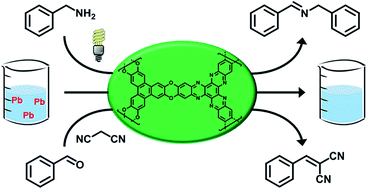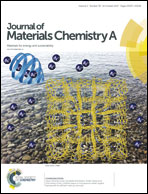A nanoporous graphene analog for superfast heavy metal removal and continuous-flow visible-light photoredox catalysis†
Abstract
We report a highly recyclable, 2D aromatic framework that offers a unique and versatile combination of photocatalytic activity and heavy metal uptake capability, as well as other attributes crucial for green and sustainable development technologies. The graphene-like open structure consists of fused tritopic aromatic building blocks (i.e., hexahydroxytriphenylene and hexaazatrinaphthylene) that can be assembled from readily available industrial materials without the need for transition metal catalysts. Besides fast and strong binding for Pb(II) ions (e.g., removing aqueous Pb ions below the drinkable limit within minutes), the alkaline N-heterocycle units of the robust and porous host are able to quantitatively catalyse Knoevenagel reactions in water. Furthermore, the fused donor–acceptor aromatic π-systems enable environmentally friendly photoredox catalysis (PRC) utilizing the safe and abundant visible light in a commercial flow reactor. Also discussed is a new metric for benchmarking the kinetic performance of sorbents in the context of heavy metal removal from drinking water.



 Please wait while we load your content...
Please wait while we load your content...